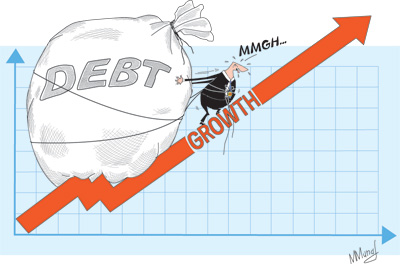Columns
On an unsustainable economic growth path
View(s): Despite the high economic growth achieved in the last few years, it is becoming increasingly evident that the growth strategy adopted is unsustainable. Economic growth is declining and fundamental macroeconomic problems are emerging. The declining trend in growth from 8.4 per cent in 2010 to 6.4 per cent last year raises serious doubts about the sustainability of this high economic growth trajectory as exports have declined, trade deficits have been massive at over US$ 9 billion, government revenue is declining as a percentage of GDP, the public debt is rising and foreign debt obligations are increasing.
Despite the high economic growth achieved in the last few years, it is becoming increasingly evident that the growth strategy adopted is unsustainable. Economic growth is declining and fundamental macroeconomic problems are emerging. The declining trend in growth from 8.4 per cent in 2010 to 6.4 per cent last year raises serious doubts about the sustainability of this high economic growth trajectory as exports have declined, trade deficits have been massive at over US$ 9 billion, government revenue is declining as a percentage of GDP, the public debt is rising and foreign debt obligations are increasing.
 Economic performance
Economic performance
The economy grew at a rapid pace in the last three years. It is expected to grow by 6.5 to 7.5 per cent this year: the latter being the estimate of the Central Bank, while the lower estimate is of the IMF. However the declining growth trend accompanied by fundamental macroeconomic problems raises doubts about the sustainability of the growth momentum.Fiscal and trade deficits are high. Exports have declined and imports are nearly twice as much as exports. Consequently trade deficits have been massive at over US$ 9 billion.
Government revenue is declining as a percentage of GDP and fiscal deficits continue to be high. Growth is leading to fundamental economic problems that would retard economic development.
Sources of growth
The paradox of growth leading to fundamental problems can be explained by analysing the nature and sources of growth, the types of investment and the sources of financing the investment. Economic growth has been achieved mainly by increases in construction, increases in some services such as expenditure on government salaries, trade related services and communications. It is these increases that have boosted growth rather than increases in agriculture and manufacturing. Furthermore this growth has been financed by debt, both local and foreign that is now a severe strain on the country’s capacity to invest.
Construction not industry
In the threefold classification of national accounts, construction is a component of industrial production. Increases in construction have brought about a growth in industry. Much of this increased construction has been government construction, though there have also been private construction of housing, hotels and business houses.
The huge investments in construction of roads and bridges, an international airport, a harbour and the development of economic infrastructure, have a long gestation period and does not add to increases in output of goods and services in the short term. At best, such returns are indirect and come after decades. They do not increase production of tradable goods right away that would help to service foreign debt both by increasing exports or increasing efficient import substitution. Furthermore, returns on some high cost investments are uncertain at present.
Investment in large infrastructure projects with low returns, long gestation periods and high import expenditure resulted in an increase in imports of construction materials and machinery that were partly responsible for large trade deficits in recent years.
Foreign debt
The Government has borrowed heavily from foreign sources to finance such investments. Foreign debt has risen sharply from US$ 15.1 billion in 2008 to US$ 28.4 billion at the end of 2012. Total foreign debt and liabilities have nearly doubled from US$ 17.8 billion in 2008 to US$ 33.7 billion and was 56.7 per cent of GDP at the end of 2012.
Government and banks have been borrowing at increasingly high interest rates and concessional borrowing has declined sharply, thereby increasing debt servicing costs.
Services
The services sector has expanded much recently and contributed nearly 60 per cent of GDP (58.5 per cent in 2012). Whether much of the services contribution to GDP is healthy is debatable.
The increase in salaries of public servants is an increase in output in national accounts. When numbers employed in the public services are increased and their salaries enhanced, the increase in expenditure on salaries becomes GDP growth. This has been a significant source of growth in GDP in 2011 and 2012. While expenditure on salaries of public servants could be justified as an important and essential service, the excessive recruitment into public services is a drag on the economy.
Trading services
Reduced import duties on motor vehicles and electronic goods in 2011 increased imports and resulted in an increase in trade related services in GDP. This increase in trade related services enhanced the growth statistic at the expense of the trade balance. Increased import taxes contributed to fiscal revenue and reduced the fiscal deficit to GDP ratio, but increasing imports widened the trade deficit.
Financing growth
The massive trade deficits were partly financed by workers’ remittances from abroad and foreign borrowing. Workers’ remittances have financed nearly 60 per cent of the trade deficits in the last two years, and are likely to finance about 70 per cent of the trade deficit this year. Foreign borrowing and workers’ remittances have made possible an unhealthy and unsustainable growth path.
Sustainable growth
Economic growth can be achieved in many ways. Some are sustainable healthy increases such as increases in agricultural and manufacturing output and tradable goods that improves the trade balance and external finances.
Increases in construction, salaries and defence expenditure and much of the increases in telecommunications do not directly contribute either to increase export earnings or savings in import expenditure. Hence we have a situation when commodity imports are about twice the value of exports.
Verite Research, the Colombo-based think tank, in a recent analysis of the economy, pointed out that: “Increasing GDP growth in a sustainable manner requires serious administrative and policy reforms involving the public sector, in education, in regulation, through technology improvements and by solving efficiency blocks in economic interactions. Shortcuts are short-lived. The trade-deficit based short-cut has expired, and the fiscal-deficit based short-cut could run a little longer”.
There is a need to change this unsustainable strategy of economic growth to ensure that the economy does not drift into an economic crisis.

